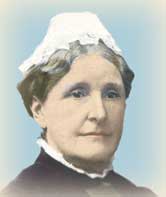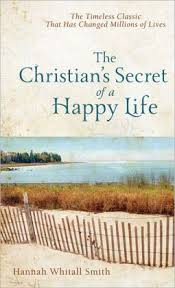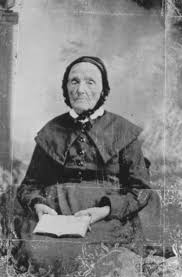“While I was yet a sinner, Christ died for me. Could anything be more liberating than that?” Hannah Whitall Smith
 Hannah Tatum Whitall came from a long line of Quakers in New Jersey. She was born in 1832, the daughter of John Mickle Whitall and Mary Tatum Whitall. Growing up as a child the rules in her home were loving but strict. Hannah focused on the legalistic side of her religion and grew up thinking God was harsh. She believed that she had to earn her own salvation by being an obedient Christian.
Hannah Tatum Whitall came from a long line of Quakers in New Jersey. She was born in 1832, the daughter of John Mickle Whitall and Mary Tatum Whitall. Growing up as a child the rules in her home were loving but strict. Hannah focused on the legalistic side of her religion and grew up thinking God was harsh. She believed that she had to earn her own salvation by being an obedient Christian.
In her teen years Hannah struggled to find a feeling of love for God. At sixteen, she expressed her emotions in her journal, “…I cannot really become righteous until I repent, and I cannot repent.” Hannah continued in her search for a relationship with God for the next few years.
In 1851 Hannah married Robert Pearsall Smith, a man who also came from a long line of Quakers in New Jersey. Hannah and Robert settled in Germantown, Pennsylvania. Their first two children were born – Nellie and Frank. Eventually Hannah would have seven children but only three would survive to adulthood.
Sadly, Nellie died at age five of a bronchial infection three days before Christmas in 1857. Hannah was deeply grieved but this turned out to be the turning point in her life.
The next summer the Smiths went on vacation at a beach in Atlantic City. Hannah packed only one book – the Bible. She was determined to get answers to her questions about God. While young Frank played in the waves on the beach, Hannah poured through the Scriptures.
One day Hannah read in Romans 5, “But God demonstrates His own love toward us, in that while we were yet sinners, Christ died for us” (Rom 5:8). Suddenly Hannah’s image of a harsh God changed into a view of a God of infinite love and grace. She wrote, “While I was yet a sinner, Christ died for me. Could anything be more liberating than that?” Hannah had found new freedom in Christ. Hannah also understood that the sorrows that God brings into our lives are for our benefit. She now had the hope that one day she would see her daughter Nellie in Heaven.
Hannah and Robert left their Friends’ church and went through several changes of churches. They were baptized by immersion in a Baptist Church in 1859 near Philadelphia. They also attended a Plymouth Brethren Church.
During the 1860’s the Smiths became interested in the teachings of the Methodists and were attracted to the Holiness Movement. Hannah and Robert adopted the Wesleyan (Methodist) doctrine of sanctification and began to write and to teach about it. Hannah began to seek the “second blessing” that many in the Holiness movement claimed as the proof that a Christian was filled with the Spirit. Though Robert had an emotional experience, Hannah never did even though she went to the altar with handkerchiefs hoping to obtain this spiritual blessing. Hannah was really concerned about this but began to study it out and later wrote about her findings in her bestselling book The Christian’s Secret of a Happy Life:
I am convinced that throughout the Bible the expressions concerning the “heart” do not mean the emotions, that which we now understand the word “heart”, but they mean the will, the personality of man, the man’s own central self, and that the object of God’s dealings with man is that this “I” may be yielded up to Him, and this central life abandoned to His entire control. It is not the feelings of the man God wants, but the man himself.
“heart” do not mean the emotions, that which we now understand the word “heart”, but they mean the will, the personality of man, the man’s own central self, and that the object of God’s dealings with man is that this “I” may be yielded up to Him, and this central life abandoned to His entire control. It is not the feelings of the man God wants, but the man himself.
Hannah had come to realize that salvation was not based on feelings or our works but on God’s faithfulness and the truth about Christ alone. She was so overjoyed by this feeling of freedom that she wished to share it with others. Hannah would eventually become a very popular speaker on God’s love and faithfulness and the Christian life.
Robert became a well-known evangelist and Hannah accompanied him on speaking tours. The two traveled in Great Britain speaking on the subjects of the “higher life” and “holiness”. They also traveled to Germany and Switzerland where they spoke in several large cities.
In August of 1872, their son Frank died at age eighteen of typhoid fever. Later that year Robert suffered from a nervous breakdown. These were trying years for Hannah. Yet, Hannah would rely on God for strength. As she grew older her faith increased.
In 1873 Robert traveled to England for the sake of his health as advised by his doctor. At age 41, Hannah was pregnant with their seventh child and she stayed behind. Soon Hannah was surprised to hear that her husband was not resting but was spending his time on a preaching tour. He had a rigorous and demanding schedule.
Hannah’s baby, a daughter, was stillborn in August. Hannah was deeply grieved but responded by throwing herself into speaking and writing in Philadelphia and Atlantic City. Robert’s ministry was growing by leaps and bounds and he urged Hannah to join him in Britain. By this time Hannah was also a well-known speaker.
Hannah agreed to join Robert in England. On board the ship on the way over she wrote most of The Christian’s Secret of a Happy Life. This book was published in 1875 and is still in print. Millions of people have been blessed by Hannah’s inspiring words of comfort and faith. (Hannah held several controversial beliefs, including universalism. These chapters have been edited out of the later editions of her book.)
Hannah arrived in England in time to attend the Brighton Conference in 1875. Eight thousand people from all over the world attended. Hannah led two Bible studies every day with 2 to 3 thousand people in attendance. Robert preached to thousands. Hannah won the hearts of vast numbers of people and became known as “the angel of the churches.” Their popularity would be short lived due to her husband’s scandal.
A few weeks before the conference ended the papers reported that Robert was accused of carrying on with a female follower. This was bad enough, but the conference organizers were also against Robert’s views about the “higher life”. Robert was following the heresy that says that believers are lifted to a higher sphere of life where Christians are no longer subject to the law of God. This is not Biblical. Could this sinful belief have anything to do with Robert’s adultery?
This scandal destroyed Robert’s reputation as a preacher. He suffered another breakdown. He became so mentally and physically fragile that Hannah had a difficult time getting him on board their ship back to America.
Hannah tried to maintain her faith in these trying circumstances by surrounding herself with good Christian friends. Robert went on to denounce Christianity for Buddhism. He continued to pursue adulterous relationships.
In all of this Hannah did not fail to turn to God. In 1878 in a letter to a friend Hannah wrote, “One thing I know, and that is that I am all the Lord’s and that His will is infinitely and unspeakably sweet to me. And like a poor little child who has lost its way I creep into the dear arms of my Father and just ask Him to carry me, since I cannot understand His directions. He doeth all things well and I can leave myself with Him.”
Hannah became a leader in the Temperance Movement and the Women’s Suffrage Movement. She spoke out for education for women. She continued to speak and write about her faith. She published more books including: Everyday Religion or The Commonsense Teaching of the Bible and The Unselfishness of God and How I Discovered It, and God of All Comfort. These works are still available today.
 In her last years, in spite of all of her suffering including her husband’s infidelities, her daughter’s scandal and divorce, and another daughter’s depression and suicide attempt, Hannah held on to her trust in God. She was able to confidently write in her final book, “God is enough! God is enough for time. God is enough for eternity. God is enough!”
In her last years, in spite of all of her suffering including her husband’s infidelities, her daughter’s scandal and divorce, and another daughter’s depression and suicide attempt, Hannah held on to her trust in God. She was able to confidently write in her final book, “God is enough! God is enough for time. God is enough for eternity. God is enough!”
Praise God – He is enough.

